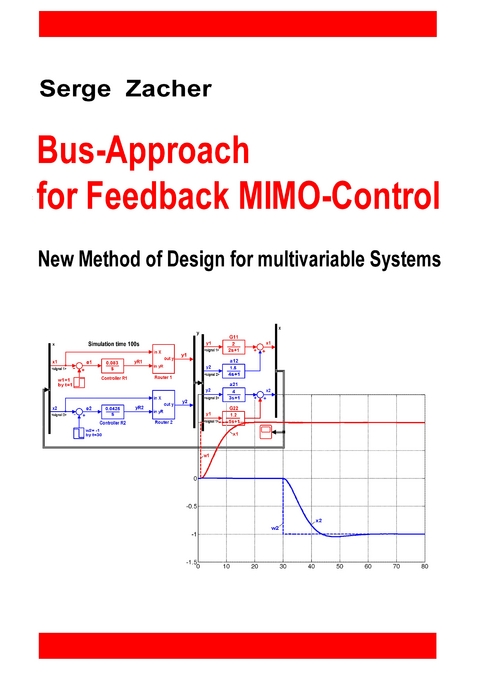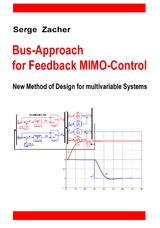Bus-Approach for Feedback MIMO-Control
Verlag Dr. Zacher
978-3-937638-24-9 (ISBN)
- Keine Verlagsinformationen verfügbar
- Artikel merken
In the book is proposed to draw the block diagram of a feedback control as a bus instead of drawing it as a closed loop. Such bus representation of a closed loop is a tool, which allows to solve many problems of the MIMO-control (multivariable control), – and to solve them very effective! – using the classical transfer function representation of plants and controllers.
For a simple control loop with only one controlled value (chapter 1) the bus-approach has not many advantages against traditional block diagram. But the use of the bus-approach for MIMO-Control has many advantages. In chapters 2 and 3 the MIMO-systems are first described with traditional methods, known in the literature. In the chapters 4 and 5 are shown, how to apply the bus-approach to the MIMO-control.
In the chapter 6 are developed and introduced new kind of MIMO-control blocks, so called Routers, by which the decoupling takes place for each controlled variable independ-ent of other neighbour variables. As far the bus-approach with MIMO-routers opens a door to a new generation of MIMO-control systems.
Dr.-Ing. Serge Zacher worked for chemical industry engineering and was professor of automation at various universities. From 1992 till 2008 he was professor of automation at University of Applied Sciences Wiesbaden (actually RheinMain-University). He published 17 Books, 150 research papers and 4 patents.
Contents
1. What is Bus-Approach?
1.1 Simple Closed Loop
1.2 Simple Closed Loop with Disturbance
1.3 Disturbance Compensation
1.4 Separate Control of two Plants
1.5 Cascade Control
1.6 Redundant Control
1.7 Summary of Chapter 1
2. MIMO-Plants
2.1 Types of MIMO-Plants
2.2 P-canonical Form and V-canonical Form
2.3 Identification of MIMO-Plant in P-canonical Form
2.4 Transformation from V- into P-canonical Form
2.5 Identification of MIMO-Plant as V-canonical Form
3. MIMO-Control
3.1 Introduction
3.1.1 Transfer Function versus State Space Model
3.1.2 Types of MIMO-Control
3.2 Decentralized MIMO-Control
3.3 Decoupling MIMO-Control
3.3.1 What is Decoupling?
3.3.2 P-canonical Plant with P-canonical Controller
3.3.3 P-canonical Plant with V-canonical Controller
3.3.4 V-canonical Plant with P-canonical Controller
3.4 Summary of Chapter 3
4. Bus-Approach for MIMO-Control
4.1 Bus-Approach for MIMO-Plants
4.2 Simulation of MIMO-Plants with Bus-Approach
4.3 Decentralized MIMO-Control
4.3.1 Decentralized MIMO-Control with Bus-Approach
4.3.2 Stability of decentralized Control with two Variables
4.3.3 Stability of decentralized Control with three Variables
4.3.4 Stability of decentralized Control with n = 4 Variables
4.4 Design of decentralized MIMO-Control
4.4.1 MIMO-plant with Static Interaction Gain C0 1
4.5 Decoupling Control with Bus-Approach
4.5.1 P-canonical Plant with V-canonical Controller
4.5.2 Decoupling MIMO-Control with three Varaibles
4.5.3 Decoupling MIMO-Control with n = 4 Variables
4.6 Structures of decoupling Control
4.6.1 P-canonical Plant with P-canonical Controller
4.6.2 V-canonical Plant with P-canonical Controller
4.6.3 V-canonical Plant with V-canonical Controller
4.7 Decoupling Control versus State Space Control
4.7.1 From Transfer Function to State Space Model
4.7.2 Controllability
4.7.3 Observability
4.7.4 Tuning of State Feedback
4.7.5 Retained Error and Scaling Matrix
4.7.6 Comparison: State Space Control and Bus-Approach
4.7 Summary of Chapter 4
5 Decoupling Control Recipes
5.1 D-Terms
5.1.1 D-Terms Problem
5.1.2 Recipe: How to avoid D-Terms
5.1.3 Recipe: How to accelerate decoupling Control
5.2 Dead-Time
5.2.1 Problem
5.2.2 Recipe: Smith-Predictor
5.3 Static Interaction
5.3.1 Static Interaction Gain C0 > 1
5.3.2 Recipe: How to control by C0 > 1
5.4 Dynamic Interaction
5.4.1 Time Delays Relation T0 < 1
5.4.2 Recipe: How to control by T0 <0
5.5 Summary of Chapter 5
6 New Generation of Decoupling MIMO-Control
6.1 MIMO-Router
6.2 Structure of MIMO-Control with Router
6.3 Summary of Chapter 6
| Erscheint lt. Verlag | 18.2.2014 |
|---|---|
| Zusatzinfo | Closed-loop. Transfer-Function. Bus-Approach Block Diagram. Cascade Control with Bus-Approach. Redundand Control with two intact Controllers. Step Response. Decentralized and diagonal MIMO-Control. MIMO-Plant in P-canonical Form. Example of stable MIMO-decentralized Control. MIMO-Plant described with state space model. Decoupling Control. Router for MIMO-Control. |
| Verlagsort | Wiesbaden |
| Sprache | englisch |
| Maße | 1700 x 2400 mm |
| Gewicht | 308 g |
| Einbandart | Paperback |
| Themenwelt | Technik ► Elektrotechnik / Energietechnik |
| Schlagworte | Entkopplungsregler • Feedback control, closed loop, redundant control, cascade control, disturbance compensation, MIMO plant, MIMO control, P-canonical form, V-canonical form,identification of MIMO plants, state space model, decoupling, bus-approach, decentralized MIMO-control • MATLAB, bus creator, bus selector, bus wire, magnitude optimization, damping, eigenvalue, frequency response, laplace -transformation, Luneberger's observer, Hurwitz stability criterion • MATLAB, bus creator, bus selector, bus wire, magnitude optimization, damping, eigenvalue, frequency response, laplace -transformation, Luneberger's observer, Hurwitz stability criterion • Mehrgrößenregelung • Redundante Regelung • Regelungstechnik |
| ISBN-10 | 3-937638-24-5 / 3937638245 |
| ISBN-13 | 978-3-937638-24-9 / 9783937638249 |
| Zustand | Neuware |
| Haben Sie eine Frage zum Produkt? |
aus dem Bereich




